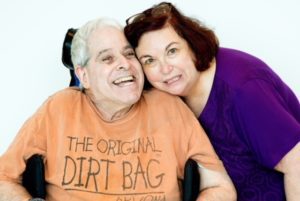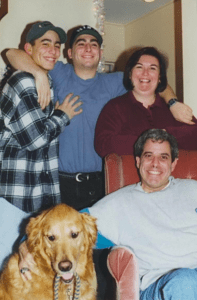48 years of marriage, 2 children, 2 nephews, 7 grandchildren, and 3 great-nieces. It is clear that Lorrie and Stewart Altman, over their time together, have created a beautiful life. When asked how they persevered in the face of challenges, Lorrie shares:
“We do what we need to do. If a situation happens, you take care of it and move on. We don’t obsess over anything or go crazy over anything.”
This outlook has not only helped the Altman family grow into what it is today, but has helped them learn about and cope with Stewart’s late-onset Tay-Sachs disease (LOTS) diagnosis.

I recently sat down with Lorrie and Stewart to discuss LOTS, building a family, and how it is possible to have a happy and fulfilling life – even with a rare disease diagnosis.
What is Late-Onset Tay-Sachs Disease (LOTS)?na
There are several different forms of Tay-Sachs disease, a rare inherited disorder that progressively destroys nerves in the brain and spinal cord: infantile, juvenile, adolescent, and late-onset. These forms all manifest in various ways and at different ages. For example, infantile Tay-Sachs disease is the most common form and appears in infancy; late-onset Tay-Sachs (LOTS) is a much rarer form in which symptoms or characteristics may not appear until late teens to early adulthood.
LOTS results from genetic mutations which prevent the body from producing enough hexosaminidase A, a type of enzyme. Because of this, the body is unable to break down gangliosides, a type of fatty compound that can damage nerve cells as they accumulate.
In Stewart’s case, Lorrie explains:
“One of the side effects is slurred speech. Stewart always had slurred speech, even as a child. Mental illness also usually shows up in late teens, but Stewart never had that. Also, he can move his arms but not above his head.”
Then, with a laugh, she continues:
“His mouth moves and then it never stops.”
Some other potential symptoms associated with LOTS include:
- Muscle weakness or twitching
- Incontinence
- Poor coordination and clumsiness
- Changes in personality
- Difficulty with memory or comprehension
- Depression or psychosis
Lorrie and Stewart’s Story
Both Lorrie and Stewart grew up in Long Island – Amityville and Franklin Square – and met at age 18 while attending Nassau Community College. According to Lorrie:
“He kept asking me out and at first, I kept saying no. But we bonded and then it was just us. Stewart was funny, cute, and crazy about me.”
By 19, Lorrie and Stewart were engaged; by 21, married. They moved into a little apartment in Franklin Square where Stewart could pursue one of his passions as a volunteer firefighter. It was during this time that Lorrie began noticing some potential coordination issues with Stewart. She explains that while he was already an EMT, he was training to become an AMT for the fire department. However:
“When he went to training to become an AMT, he wasn’t able to start a line because he lacked the dexterity in his hands. So he joined the rescue unit.”
When Lorrie’s mother passed away, Lorrie and Stewart moved into the house, which Lorrie says came with the dog, her 18-year-old brother, and everything her mother had. By this time, Stewart’s coordination problems were becoming increasingly more present; he had some difficulty walking and running, or getting to fires on time, so he unfortunately had to give up his time with the fire department.
He began working in New York City as the Head of the Mail Department for an engineering firm, but also seemed to have a more difficult time climbing the stairs or holding onto the railing for the Long Island Rail Road or subway.
Receiving the LOTS Diagnosis
In her teenage years, Stewart’s sister Rosiland (Rozy) began experiencing bouts of mental illness. Her teenage and young adult years were spent in and out of various hospitals as she grappled with these difficulties. However, this also meant that her children experienced some instability in their upbringing.
As Rozy was managing her illness, Stewart and Lorrie had the opportunity to step in and help their family by taking in her two children. Lorrie and Stewart had just had their first child, Brett, one year before. But there was no question of what to do to help:
“We took them in, our two nephews. So we had a 1-year old, an 11-year-old, and a 14-year-old. We just made a family.”
While the mental illness manifested in her younger years, Rozy began experiencing physical symptoms in her late 30s: slurred speech, changes in coordination, and difficulty walking and climbing stairs. After her psychiatrist referred her to Head Geneticist Dr. Robert Desnick at Mount Sinai, Stewart’s sister was diagnosed with LOTS. At this point, she shared that Stewart also had trouble with coordination. The hospital called Lorrie and Stewart. After a blood test and muscle biopsy, Stewart received his diagnosis in 1978. Lorrie explains:
“Both of his parents must have been carriers. At the time, we were not told the name late-onset Tay-Sachs. We were told that it was GM2 gangliosidosis.”
Around this same time, Lorrie was pregnant. She later gave birth to another boy, who was diagnosed as hearing impaired at 3 months old. But neither this nor the GM2 gangliosidosis diagnosis set the Altman family back. Lorrie explains:
“Stewart and I just lived our lives. Once a year, we went to Mount Sinai for tests, but for the most part, we just moved forward. In 1981, Stewart got his degree, and then I went back to school too.”
Living with LOTS
In 1981, Stewart had to leave his job and began the long process of applications and interviews. Unfortunately, many jobs declined hiring him based on how he walked or talked. Eventually, Stewart received a job at the Nassau County Medical Center, where he worked for 31 years in different capacities as his condition progressed.
Throughout this time, Stewart also had his first Canine Companion for Independence, who he named Civitan (“Civi”). Lorrie laughs as she shares:
“Everybody knew Stewart and Civi. Sometimes people would invite us to places just for the dog, I think.”

Civi retired at 13 years, after which time their next dog, Kien, began coming to work with Stewart. Stewart and Lorrie also began making adjustments to their day-to-day life to help streamline their schedule. For example, Stewart would get up at 4am to get dressed for work because it began taking longer, or would leave at 6am instead of 8am to get to work early. Lorrie explains:
“It never seemed like it was out of character. It’s just the way we worked. You just do what you need to do.”
Stewart enjoyed his job – and some of the funny situations that emerged. For example, the handicap parking was close to the emergency room. Stewart drove a station wagon; the back came down so he could sit on it. He would walk along the side of the car, pull the back down, and remove his wheelchair; the dog would wait in the car and jump out on command. One day, shares Stewart, a woman stopped to ask if she could help him. When the dog jumped out, the woman asked if he was blind.
“Yeah,” Stewart said. “The dog drove.”
Join us tomorrow for Part 2 of the interview, where we cover advocacy, the family dynamic, and how to find support when handling a LOTS diagnosis.






